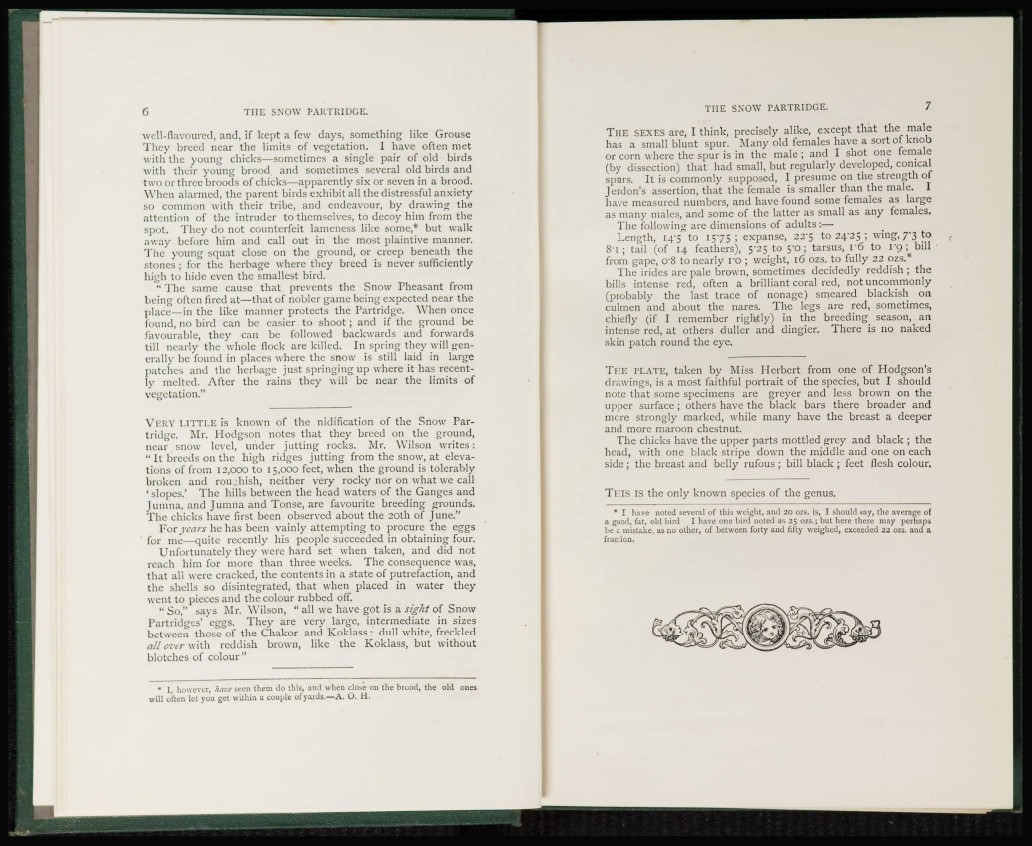
6 THE SNOW PARTRIDGE.
well-flavoured, and, if kept a few days, something like Grouse
They breed near the limits of vegetation. I have often met
with the young chicks—sometimes a single pair of old birds
with their young brood, and sometimes several old birds and
two or three broods of chicks—apparently six or seven in a brood.
When alarmed, the parent birds exhibit all the distressful anxiety
so common with their tribe, and endeavour, by drawing the
attention of the intruder to themselves, to decoy him from the
spot. They do not counterfeit lameness like some,* but walk
away before him and call out in the most plaintive manner.
The young squat close on the ground, or creep beneath the
stones ; for the herbage where they breed is never sufficiently
high to hide even the smallest bird.
" The same cause that prevents the Snow Pheasant from
being often fired at—that of nobler game being expected near the
place—in the like manner protects the Partridge. When once
found, no bird can be easier to shoot; and if the ground be
favourable, they can be followed backwards and forwards
till nearly the whole flock are killed. In spring they will generally
be found in places where the snow is still laid in large
patches and the herbage just springing up where it has recently
melted. After the rains they will be near the limits of
vegetation."
VERY L I T T L E is known of the nidification of the Snow Partridge.
Mr. Hodgson notes that they breed on the ground,
near snow level, under jutting rocks. Mr. Wilson writes:
" It breeds on the high ridges jutting from the snow, at elevations
of from 12,000 to 15,000 feet, when the ground is tolerably
broken and roughish, neither very rocky nor on what we call
' slopes.' The hills between the head waters of the Ganges and
Jumna, and Jumna and Tonse, are favourite breeding grounds.
The chicks have first been observed about the 20th of June."
For years he has been vainly attempting to procure the eggs
for me—quite recently his people succeeded in obtaining four.
Unfortunately they were hard set when taken, and did not
reach him for more than three weeks. The consequence was,
that all were cracked, the contents in a state of putrefaction, and
the shells so disintegrated, that when placed in water they
went to pieces and the colour rubbed off.
" So," says Mr. Wilson, " all we have got is a sight of Snow
Partridges' eggs. They are very large, intermediate in sizes
between those of the Chakor and Koklass: dull white, freckled
all over with reddish brown, like the Koklass, but without
blotches of colour"
* I however, have seen them do this, and when close on the brood, the old ones
will often let you get within a couple of yards.—A. O. H.
THE SNOW PARTRIDGE. 7
T H E SEXES are, I think, precisely alike, except that the male
has a small blunt spur. Many old females have a sort of knob
or corn where the spur is in the male ; and I shot one female
(by dissection) that had small, but regularly developed, conical
spurs. It is commonly supposed, I presume on the strength of
Jerdon's assertion, that the female is smaller than the male. I
have measured numbers, and have found some females as large
as many males, and some of the latter as small as any females.
The following are dimensions of adults :—
Length, 14-5 to 1 5 7 5 ; expanse, 22-5 to 24^25 ; wing, 7'3 to
81 ; tail (of 14 feathers), 5-25 to 5-0; tarsus, v6 to 1-9; bill
from gape, 0'8 to nearly r o ; weight, 16 ozs. to fully 22 ozs.*
The irides arc pale brown, sometimes decidedly reddish ; the
bills intense red, often a brilliant coral red, not uncommonly
(probably the last trace of nonage) smeared blackish 011
culmen and about the nares. The legs are red, sometimes,
chiefly (if I remember rightly) in the breeding season, an
intense red, at others duller and dingier. There is no naked
skin patch round the eye.
T H E PLATE, taken by Miss Herbert from one of Hodgson's
drawings, is a most faithful portrait of the species, but I should
note that some specimens are greyer and less brown on the
upper surface; others have the black bars there broader and
more strongly marked, while many have the breast a deeper
and more maroon chestnut.
The chicks have the upper parts mottled grey and black ; the
head, with one black stripe down the middle and one on each
side ; the breast and belly rufous ; bill black ; feet flesh colour.
T H I S IS the only known species of the genus.
* I have noted several of this weight, and 20 ozs. is, I should say, the average of
a good, fat, old bird I have one bird noted as 25 ozs.; but here there may perhaps
be a mistake, as no other, of between forty and fifty weighed, exceeded 22 ozs. and a
fraction.